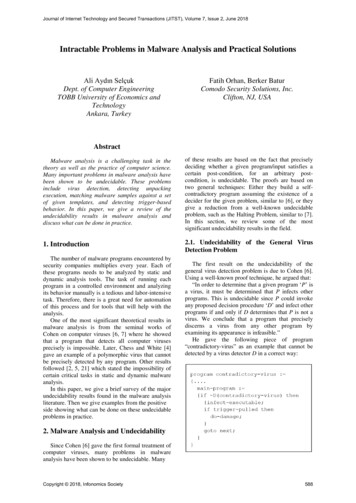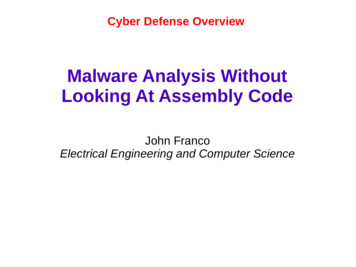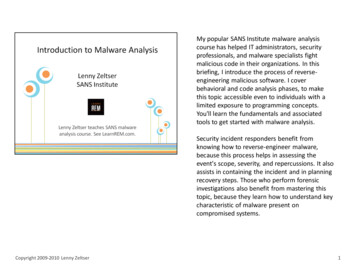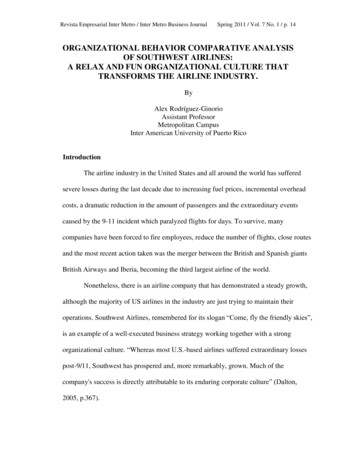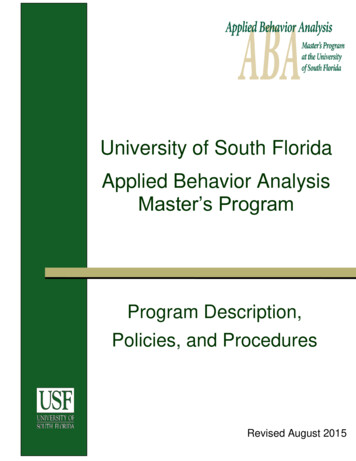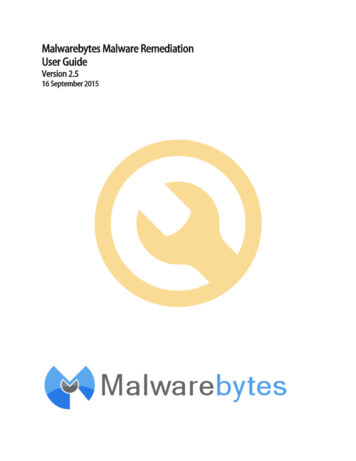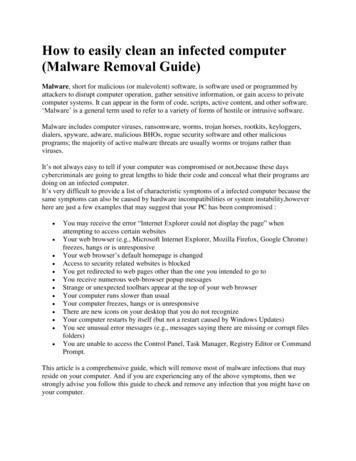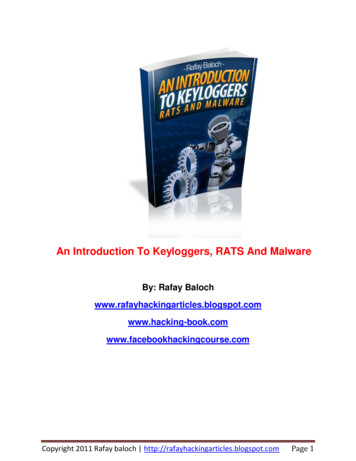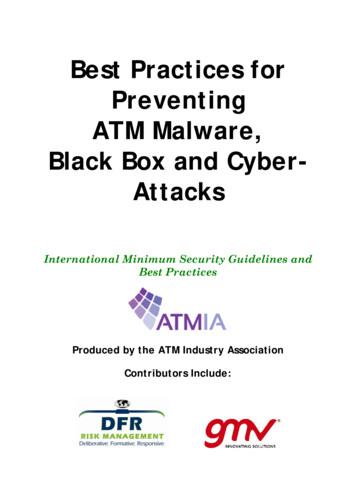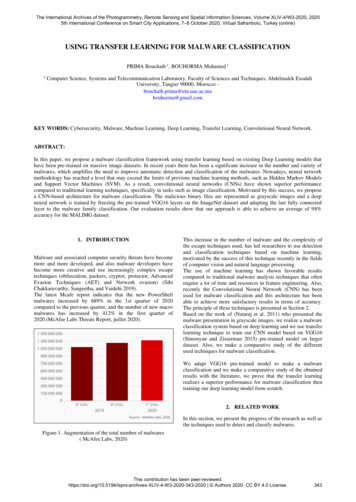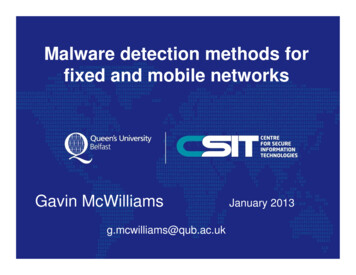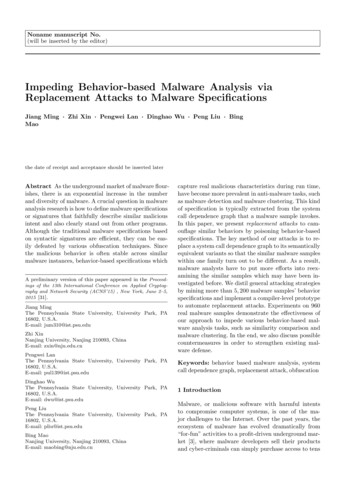
Transcription
Noname manuscript No.(will be inserted by the editor)Impeding Behavior-based Malware Analysis viaReplacement Attacks to Malware SpecificationsJiang Ming · Zhi Xin · Pengwei Lan · Dinghao Wu · Peng Liu · BingMaothe date of receipt and acceptance should be inserted laterAbstract As the underground market of malware flourishes, there is an exponential increase in the numberand diversity of malware. A crucial question in malwareanalysis research is how to define malware specificationsor signatures that faithfully describe similar maliciousintent and also clearly stand out from other programs.Although the traditional malware specifications basedon syntactic signatures are efficient, they can be easily defeated by various obfuscation techniques. Sincethe malicious behavior is often stable across similarmalware instances, behavior-based specifications whichA preliminary version of this paper appeared in the Proceedings of the 13th International Conference on Applied Cryptography and Network Security (ACNS’15) , New York, June 2–5,2015 [31].Jiang MingThe Pennsylvania State University, University Park, PA16802, U.S.A.E-mail: jum310@ist.psu.eduZhi XinNanjing University, Nanjing 210093, ChinaE-mail: zxin@nju.edu.cnPengwei LanThe Pennsylvania State University, University Park, PA16802, U.S.A.E-mail: pul139@ist.psu.eduDinghao WuThe Pennsylvania State University, University Park, PA16802, U.S.A.E-mail: dwu@ist.psu.eduPeng LiuThe Pennsylvania State University, University Park, PA16802, U.S.A.E-mail: pliu@ist.psu.eduBing MaoNanjing University, Nanjing 210093, ChinaE-mail: maobing@nju.edu.cncapture real malicious characteristics during run time,have become more prevalent in anti-malware tasks, suchas malware detection and malware clustering. This kindof specification is typically extracted from the systemcall dependence graph that a malware sample invokes.In this paper, we present replacement attacks to camouflage similar behaviors by poisoning behavior-basedspecifications. The key method of our attacks is to replace a system call dependence graph to its semanticallyequivalent variants so that the similar malware sampleswithin one family turn out to be different. As a result,malware analysts have to put more efforts into reexamining the similar samples which may have been investigated before. We distil general attacking strategiesby mining more than 5, 200 malware samples’ behaviorspecifications and implement a compiler-level prototypeto automate replacement attacks. Experiments on 960real malware samples demonstrate the effectiveness ofour approach to impede various behavior-based malware analysis tasks, such as similarity comparison andmalware clustering. In the end, we also discuss possiblecountermeasures in order to strengthen existing malware defense.Keywords: behavior based malware analysis, systemcall dependence graph, replacement attack, obfuscation1 IntroductionMalware, or malicious software with harmful intentsto compromise computer systems, is one of the major challenges to the Internet. Over the past years, theecosystem of malware has evolved dramatically from“for-fun” activities to a profit-driven underground market [3], where malware developers sell their productsand cyber-criminals can simply purchase access to tens
2Jiang Ming et al.of thousands of malware-infected hosts for nefariousware variants show large distances and are assigned topurposes [1]. Normally malware developers do not writedifferent families. Eventually, malware analysts have tonew code from scratch, but choose to update the oldput more efforts into reanalyzing a large number of malcode with new features or obfuscation methods [28].ware samples exhibiting similar functionalities. In thisWith thousands of malware instances appearing everyway, the effect of replacement attacks looks like theday, efficiently processing a large number of malwaredenial-of-service attack. To achieve this goal, we firstsamples which exhibit similar behavior, has become inmine two large data sets to identify popular systemcreasingly important. A key step to improve efficiencycalls, OS objects, and their dependencies. We summais to define the discriminative specifications or signarize two general attacking strategies to replace SCDG:tures that faithfully describe intrinsic malicious intents1) mutate a sequence of dependent system calls (subso that malware samples with similar functionalitiesSCDG) to its equivalent ones, and 2) insert redundanttend to share common specifications. Malware analystsdata flow dependent system calls. Our approach ensuresbenefit from such general specifications. For example,that: 1) the transformation is semantics persevering;every time a suspicious program is found in the wild,2) the new generating dependence relationships are somalware analysts can quickly determine whether it becommon that they cannot be easily recognized. Afterlongs to previously known families by matching theirtransformation, similar malware samples reveal a largespecifications.distance when they are measured with widely used simIn the malware arms race, the malicious code keepsilarity metrics, such as graph edit distance [13] and Jacevolving to evade detection. The classical syntactic speccard Index [11]. As a result, the further analyses thatifications are insufficient to defeat various obfuscationrely on SCDG (e.g., malware detection and clustering)techniques, such as polymorphism [26], binary packare possibly misled.ing [39], and self-modifying code [12]. In contrast, behaviorTo demonstrate the feasibility of replacement atbased specifications, which are generated during maltacks, we have developed a compiler-level prototype,ware execution, are more resilient to static obfuscationAPI Replacer, to automatically perform the transformethods and able to represent the malicious behaviormation on top of LLVM framework [27] and Microsoftnaturally, such as download and execution, replicationVisual Studio. Given a single malware source code, APIand remote injection. The main interface for malwareReplacer is able to generate multiple malware binaries,to interact with the operating system is through systemand each one exhibits different behavior specifications.calls1 . The data flow dependencies among system callsWe evaluate our replacement attacks on a variety of realare expressed as an acyclic graph, namely system callmalware samples with different replacement ratio. Ourdependency graph (SCDG), where the nodes representexperimental result shows that our approach successthe system calls executed, and a directed edge indicatesfully clutters both SCDG structures and the higher levela data flow between two nodes. Typically, a dependencyabstractions from SCDG. In addition, we demonstrateedge derives from the return value or the output arguthat the further analysis tasks such as malware simiment of a previous system call. When a data sourcelarity comparison and behavior-based malware clusteris passed to one of its succeeding system call’s inputing are misled as well. The cost of transformation isargument, a directed edge connecting these two nodeslow, and the execution overhead after transformation isis created. Since such data flow dependencies are stablemoderate. Note that our approach does not look forand hard to be reordered, SCDG has been broadly acmaking malware analysis infeasible, but seeks to incepted as a reliable abstraction of malware behavior [15,crease the costs of automatical malware defense solu20], and widely employed in malware detection [6, 25]tions, which is practical in the malware arms race.and large scale malware clustering [7, 35].In summary, we make the following contributions:With quite a number of compelling applications, themalware specifications built on SCDG look promising.– We propose replacement attacks to camouflage simHowever, it is not impossible to circumvent. In orderilar behavior specifications among malware variantsto inspire more state-of-the-art malware analysis techby replacing system call dependence graphs.niques, we exploit the limitations of the current ap– We summarize the rules for equivalent replacementsproaches and present replacement attacks against behaviorby mining a large set of malware samples. The disbased malware analysis. We show that it is possibletilled attacking strategies tangle structure of systemto automatically conceal similar behavior specificationscall dependency as well as behavior feature set withamong malware variants by replacing an SCDG to itsout affecting semantics.semantically equivalent ones. As a result, similar mal– We automate the replacement attacks by develop1 The systems call in Windows NT is called native APIing a compiler-level prototype to perform source
Impeding Behavior-based Malware Analysis via Replacement Attacks to Malware Specifications3ysis as well. Since collecting malware behavior is typically performed in a controlled sandbox environment,the lion’s share of previous work focuses on runtimeenvironment detection [14, 18, 34, 37]. If a malware sample detects itself running in a sandbox rather than realphysical machine, it will not carry out any maliciousbehaviors. Multiple ways have been proposed to deThe rest of the paper is organized as follows. Secfeat such environment-sensitive malware. Dinaburg ettion 2 introduces previous work on behavior based malal. [17] utilize hardware virtualization to build a transware analysis. Section 3 describes in detail about howparent analysis platform, which remains invisible toto generate replacement attacks rules with a case study.such sandbox environment check. Another direction reSection 4 highlights some of our implementation choices.lies on contrasting different executions of a malwareWe present the evaluation of our approach in Section 5.sample when running in multiple sandboxes. The conPossible countermeasures are discussed in Section 6 andtrol flow deviations indicate possible evasion attempts [22].we conclude the paper in Section 7.Our method does not detect sandbox and is valid in anyruntime environment. Our replacement attacks sharethe similar goal with recent work by Biggio et al. [9,2 Related Work10] in that we all attempt to subvert malware clusterIn this section, we first present previous work on behavior- ing. However, our work is different from these previouswork in two ways. First, our approach obfuscates databased malware analysis, which is related to our workflow dependencies between system calls; while the bein that these methods rely on system call sequences orhavior features that they attack do not contain datagraphs and therefore they are the candidates of replaceflow dependencies. As the data flow relationships bement attacks targets. Then, we introduce previous retween system calls or behavior features are highly research on impeding malware dynamic analysis. In prinsilient to random noise insertion, our attacking methodciple, our approach belongs to this category. At last, weis more challenging. Second, Biggio et al.’s work has adescribe related work on system call API obfuscation,common “inverse feature-mapping” problem [10], thatwhich is close in spirit to our approach.is, they directly manipulate malware behavior featureBehavior based malware analysis Malware dynamic anal- set instead of real malware code. Therefore, their attacks may not be feasible in practice. In contrast, toysis techniques are characterized by analyzing the acdemonstrate the feasibility of our approach, we developtual executing instructions of a program or the effectsa compiler-level converter to perform the real replacethat this program brings to the operating system. Comment attacks.pared with static analysis, dynamic analysis is less vulnerable to various code obfuscation schemes [32]. Christodorescu et al. [15] introduce malware specifications builtSystem call obfuscation The original idea to obfuscateon data flow dependencies among system calls, whichsystem call API can be traced back to mimicry atcapture true relationships between system calls and aretack [19, 43], whose primary goal is to impede intrusionhard to be circumvented by random system call injecdetection. Kim et al. [23] present a polymorphic attacktion. Since then, the malware specifications based onto sequence-based software birthmarks. Illusion [42] alSCDG have been widely used in malware analysis tasks,lows user-level malware to invoke kernel operations withsuch as extracting malware discriminative feature byout calling the corresponding system calls. To launchmining the difference between malware behavior andthe Illusion attack, the attacker has to install a mabenign program behavior [20, 21, 33], determining mallicious kernel module, which is not practical in manyware family in which the instances share similar funcreal attacking scenarios. Ma et al. [29] present shadowtionalities [7, 24, 6, 35], and detecting malicious behavattacks by partitioning a malware sample into multiior [8, 25, 30] by matching behavior-based malware specple shadow processes and each shadow process revealsifications. However, none of the presented approachesno-recognizable malware behavior. But it’s still an openis explicitly designed to be resilient to our replacementquestion to launch a multi-process sample covertly. Ourattacks.proposed attacks are inspired by Xin et al. [45]’s approach to subverting behavior based software birthmark. However, their attacking method is restricted toMalware behavior analysis attacks As behavior-basedreplacing a dependency edge with a new vertex andmalware analysis has become prevalent, some countertwo new edges. As shown in Section 5.2, this simplemeasures have been proposed to evade this kind of analto binary transformation. The experimental resultsdemonstrate our approach is effective.– To the best of our knowledge, we are the first oneto demonstrate the feasibility of automatically obfuscating behavior-based malware clustering on realmalware samples.
4Jiang Ming et al.attacking method only has limited effect on reducingJaccard Index value. In contrast, our approach provides multiple attacking strategies. In addition, Xin etal. [45]’s attack code is pre-loaded as a dynamic librarywhen a program starts running. However, it is quiteeasy to detect such library interruption. Our API Replacer embeds new system call dependencies at LLVMIL level and then compiles the modified IL to the binary code transparently. In this way, our approach hasbetter stealth.As a result, the return value of “SetFilePointer” (“dwFilePosition”), is equal to the “hFile1”. Then “dwFilePosition” is passed to “NtClose” to close the file. Whencalling “SetFilePointer”, the native API “NtSetInformationFile” is invoked to change the position information of the file object represented by “hFile1”. In thisway, the new code still preserves the original data flow,while the structure of original SCDG changes significantly. Note that the file object in Fig. 1 (b) is updatedwith new position information. However, the file objectis closed immediately, imposing no lasting side effect tothe final state.3 Replacement Attacks DesignIn this section, we present the key design of replacementattacks. We start by introducing the background information about system call dependency graph (SCDG).Our approach attempts to obfuscate the structure ofSCDG. Then we discuss the threat model of replacement attacks. The design of replacement attacks is inspired by two studies we performed. After that, we willintroduce our replacement attacks arsenal with a motivating example.3.1 BackgroundIn spite of various obfuscation methods (e.g., metamorphism and polymorphism) that the malware authorsadopt, malware samples within the same family tendto reveal similar malicious behavior [28]. Our goal inthis paper is to separate similar malware variants bymodifying the structure of SCDG, which is the mostprevalent specification to represent malware behavior.Fig. 1 shows an example of SCDG before/after replacement attacks. At the top of Fig. 1, we list pseudo codefragment written in MSVC for ease of understanding2 .In the original SCDG (as shown in Fig. 1 (a) ), the return value of “NtCreateFile” is a FileHandle (“hFile1”),denoting the new created file object. As hFile1 is passedto “NtClose”, a data flow dependency connects “NtCreateFile NtClose”. Windows API “SetFilePointer” inthe new code (as shown in Fig. 1 (b) ) moves the filepointer and returns new position, which is quite similar to “lseek” system call in Unix. The return value of“SetFilePointer” is equal to moving distance plus theoffset of starting point, which is 0 (“FILE BEGIN”) inthis example. We exploit the fact that the data type of“hFile1” and the distance to move are both unsignedintegers, and deliberately assign the distance to movewith the same value of “hFile1” (line 2 in the new code).2In the code, we use Windows API as a proxy for Windowsnative API. We will discuss this issue further at Section 4.3.2 Threat ModelA typical threat model to apply replacement attacksis illustrated in Fig. 2. Before propagating malwaresamples, malware authors take the initial version ofmalware source code as input to API Replacer, ourcompiler-level transformation tool. The outputs are multiple malware variants in binary form. The generatedvariants share very similar malicious functionalities butexhibit different behavior specifications. Then cybercriminals spread these malware samples to the Internet or plant them in the vulnerable hosts to performmalicious purposes. Suppose these new malware variants, with other suspicious binaries are finally collectedby anti-malware companies. To classify a large number of malware and select the samples that need further investigations, anti-malware companies utilize automated clustering tools to identify samples exhibitingsimilar behavior. These tools normally execute malwareinstances in a sandbox and collect runtime information (e.g., system alls and their arguments) to generate behavior specifications (e.g., SCDG), which will benormalized and then fed to clustering algorithm. Aswe mentioned in Section 2, current malware clusteringtools are not designed to defeat replacement attacks explicitly. Therefore, the very similar malware mutationsafter replacement attacks are probably assigned to multiple clusters instead of one cluster. In that case, malware analysts have to waste excessive efforts to reanalyze these similar samples and the samples that requiremore attention may be left in the basket.3.3 Mining Two Large Data SetsSince there are various expressions of malware behavior based on SCDG, we first mine two large and representative data sets of malware behavior specificationsused for malware detection and clustering. The min-
Impeding Behavior-based Malware Analysis via Replacement Attacks to Malware Specifications1: HANDLE hFile1 CreateFile (“logfile”,GENERIC READ, .);2: CloseHandle (hFile1);1: HANDLE hFile1 CreateFile (“logfile”,GENERIC READ, .);2: DWORD dwFilePosition SetFilePointer(hFile1, (DWORD) hFile1, NULL, FILE BEGIN);3: CloseHandle ( (HANDLE) FilePositionNtClose(b) the new SCDG(a) the original SCDGFig. 1 An example of SCDG before and after replacement attacks.Binary 1MalwareSource CodeAPI Replacer.InternetBinary lware AnalysisSandboxGenerate MalwareBehavior SpecificationsFig. 2 Illustration of replacement attacks threat model.ing results are popular dependencies and common subSCDGs, which are the possible targets we may attack.– BRS-data [6] is used by Babić et al. to evaluate malware detection via tree automata inference. BRSdata contains system call dependency graphs generated for 2631 malware samples and covers a largevariety of malware, such as trojan, backdoor, worm,and virus.– BCHKK-data [7] is used for evaluating malware clustering technique proposed by Bayer et al. BCHKKdata includes behavior profiles extracted from 2658malware samples, and more than 75% samples arethe variants of Allaple worm. Note that the twodimensional structure of SCDG is not amenable toscalable clustering techniques, which usually operate on numerical vectorial feature set. Bayer et al.converted system call dependencies to a set of features in terms of operations (create, read, write,map, etc.) on OS objects (file, registry, process, section, thread, etc.) and dependencies between OS objects.These two data sets reflect two typical applicationsof SCDG to represent malware specifications: 1) di-rectly utilize rich structural information contained inSCDG [15, 36, 20], which is able to match behavioralpatterns exactly but lacks scalability; 2) extract higherlevel abstractions from SCDG to fit for efficient largescale malware analysis [7, 8, 38] at the cost of precision. The similarity of instances in BRS-data is normally measured by graph edit distance or graph isomorphism [13]; while the similarity metrics of BCHKK-datais calculated by Jaccard Index [11]. Our approach isdesigned to attack the malware specifications like bothBRS-data and BCHKK-data.3.3.1 Popular DependenciesWe calculate the most popular native API dependencies from BRS-data, OS operations and dependenciesfrom BCHKK-data. Table 1 lists eleven popular nativeAPI dependencies out of BRS-data, which are mainlyrelated to the operations on Windows registry, memory,and file system. The second column is the medium dataflow types passed between system calls. Most of themedium types are handles, which stands for various OSobjects such as file, registry, section (memory-mappedfile), process, etc. Table 2 presents popular OS object
6Jiang Ming et al.Table 1 Popular windows native API dependencies.DependenciesNtMapViewOfSection NtProtectVirtualMemoryNtOpenKey NtQueryValueKeyNtCreateSection NtMapViewOfSectionNtMapViewOfSection NtUnmapViewOfSectionNtOpenSection NtMapViewOfSectionNtCreateFile NtReadFileNtCreateSection NtQuerySectionNtOpenKey NtQueryKeyNtCreateFile NtQueryInformationFileNtOpenFile NtSetInformationFileNtOpenProcess NtWriteVirtualMemoryTable 2 Popular OS object types, operations and dependen-Data flow typesvoid *addressKeyHandleSectionHandlevoid dleFileHandleFileHandleProcessHandleRatio (%)22.419.49.68.96.35.44.84.64.24.13.83.4 Attacking Strategiescies.OS object typefileOS operationopen, create, read, write,set information, query file,query information, query directoryregistrycreate, open, query value, set valuesectionquery, create, map, open, mem readprocesscreate, open, querycreate, query, resumethreadOS object dependencyfile file, registry file, registry registry,process thread, section file, file sectionIn this section we elaborate how to construct replacement attacks strategies. We propose three criteria thatour attacking strategies have to meet:3.3.2 Common Sub-SCDGs1. (R1) Potency: our replacement attacks should obfuscate the malware specifications like both BRSdata and BCHKK-data. In another word, replacement attacks have to invalidate various malware behavior similarity metrics, such as graph edit distance and Jaccard Index.2. (R2) Semantics-preserving: new system calls and dependencies impose no side effect to the original dataflow.3. (R3) Stealth: the transformed SCDG should be ascommon as possible so that replacement attacks cannot be easily identified.Although extracted from two different sources, the datain Table 1 and Table 2 reveal some common maliciousfunctions, which are mapped to sub-SCDGs. The topthree popular sub-SCDGs are corresponding to malware replication, registry modification for persistenceand code remote injection. For example, the commondependencies about “NtMapViewOfSection” and theOS objects dependency between file and section, indicate that malware replications are commonly implemented via memory mapped file, which directly mapsa malware sample into a memory area to speed up diskI/O. Besides, malware instances often configure Windows registry for persistence in order to run automatically when the compromised machine restarts, leadingto frequent operations on Windows registry. “NtOpenProcess NtWriteVirtualMemory” and “process thread” are mainly introduced by creating a new threadin a remote process, the most common way to launchmalware covertly in vulnerable hosts [41]. If we are ableto implement these common functions through different ways, the corresponding sub-SCDGs are very likelychanged as well.We meet our design requirement R1 by two attacking methods. The first one is embedding redundant dataflow dependent system calls to replace original populardependencies. As a result, new vertices and dependencies are created (see example in Fig. 1). At the sametime, we make sure data types and values of originaldependencies are preserved (satisfy R2).Furthermore, we observe that malicious functionalities can be developed with different technical methods,making it possible for SCDG mutations without undermining the intended purpose. For example, a popularmalicious behavior—malware replication, can be implemented through two methods. The first one is utilizing memory-mapped file to speed up disk I/O, and thenative APIs such as NtCreateSection, NtMapViewOfSection, and NtUnmapViewOfSection are involved. Thesecond IO method is via the conventional file manipulating native APIs, such as NtCreateFile, NtReadFile,and NtSetInformationFile. The SCDGs under these twomethods are completely different. Therefore, our second attacking strategy is to transform a sub-SCDG toits semantically equivalent mutations (satisfy R2). Astypes, operations and dependencies from BCHKK-data.We believe as long as we diversify these popular dependencies and behavior features, the similarity amongmalware variants can drop significantly.
Impeding Behavior-based Malware Analysis via Replacement Attacks to Malware Specificationsa result, the original dependencies probably do not exist anymore. A by-product of our mining result in Section 3.3 is that popular dependencies can also be servedas possible candidates to be embedded in an SCDG sothat the new SCDG doesn’t look unusual (satisfy R3).Note that these two attacking methods can seamlesslyweave together to amplify each other’s effect.3.5 Replacement Attacks ArsenalIn this section we present the details of our replacementattacks arsenal. According to our attacking strategies,we classify them into two categories:3.5.1 Inserting Redundant DependenciesWe summarize attacks belong to this category based onthe medium data flow types listed in Table 1.1. “NtSetInformationFile” attack. This attack can replace the dependencies that use FileHandle as themedium. NtSetInformationFile is used to adjust thefile pointer. By carefully crafting the input arguments, we can make “NtSetInformationFile” as anull operation. We have illustrated such example inFig. 1.2. “NtDuplicateObject” attack. “NtDuplicateObject”returns a duplicated object handle, which refers tothe same object as the original handle.3. “NtQuery*” attack. There are several Windows native APIs for querying information of kernel objects,such as “NtQueryAttributesFile”, “NtQueryKey”,“NtQueryInformationProcess” and “NtQueryInformationFile”. All of these query APIs take certainobject handle as one of input argument and output object information. No any modification is introduced to the kernel objects. Hence “NtQuery*”native APIs are good candidates for our replacement attacks. For example, we could insert “NtQueryInformationFile” into a popular NtCreateFile NtSetInformationFile dependency, where the output of “NtQueryInformationFile” (“FileInformation”)is passed to “NtSetInformationFile”. The two newdependencies also appear commonly.4. The medium of “void *address” shown in Table 1 receives the address of a mapped memory. To handlethis medium, we can insert “NtQueryVirtualMemory” or “NtReadVirtualMemory”, which do not affect the memory mapped address.3.5.2 Sub-SCDG MutationsWe present multiple implementation ways to achievethe top three popular malicious sub-tasks discussed in7Section 3.3.2. Furthermore, we make sure that each implementation reveals a different sub-SCDG with theothers.1. Replication. When malware authors call WindowsAPI “CopyFile” to replicate malware sample fromsource to target file, it is actually achieved throughmemory mapped file. When a process maps a fileinto its virtual address space, the following reading and writing to the file are simply manipulating the mapped memory region, which produces OSobjects dependencies between file and memory section. First, we can choose to map either the sourceor destination file to the memory section. Anotherimplementation is explicitly through file I/O operations. For example, we can copy a file by calling“NtReadFile” and “NtWriteFile” instead of usingmemory as the medium.2. Modify registry for persistence. Malware often addentries into the registry to remain active after rebooting. There are multiple registry keys that canbe configured to load malware at startup. The reference [4] lists 23 registry keys are accessed duringsystem start. We leverage these multiple choices torandomly pick up available registry keys to modify.3. Code remote injection. Malicious code can be injected into another running process so that the process could execute the malware unwittingly. To achievethis functionality, we can either inject the maliciouscode directly into a remote process; or put the codeinto a DLL and force the remote process to loadit [41].3.6 Case StudyFor a better understanding of our replacement attacks,we provide a real case to mutate the replication behavior of Worm.Win32.Hunatcha. Fig. 3(a) shows a native API sequence fragment we collected from the initial version and the corresponding SCDG. The malware sample replicates the file “hunatcha.exe” to “ladygaga.mp3.exe” by first memory-mapping the source
making malware analysis infeasible, but seeks to in- . tions, which is practical in the malware arms race. In summary, we make the following contributions: { We propose replacement attacks to camou age sim-ilar behavior speci cations among malware
